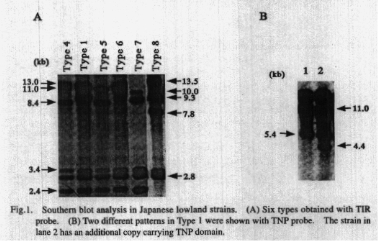|
41. Copy number of RMu elements in Japanese lowland rice
landrace
Rice Mutator (RMu) transposable
element is a homolog of maize Mutator transposon which is well known to
be used to tag genes in maize genome (Bennetzen eta!. 1993). In this report,
we examined variation of copy numbers of RMu element in Japanese cultivars
to study transposition events which may have happened in the past. This
information would be useful in searching for currently active elements.
To estimate copy number of RMu elements, we used two probes named as TNP
and TIR. TNP is a PstI-XhoI fragment of an orf in RMu1-IR36, carrying a
conservative putative transposase domain abbreviated as TNP domain, (Ishikawa
and Freeling in press). TIR is 3’ sequences of RMu1-1R36 including a 193bp
right termini. We counted number of bands detected in southern blots as
copy number in rice genome when genomic DNA was digested with SadI and
probed with TIR or TNP, because SadI does not cut inside of RMu elements
ever cloned (data not shown). TNP was used to count copy number of elements
in RMu1 class carrying TNP domain and TIR to count additional copies in
RMu2 class which has no TNP domain but homologous termini.
Genomic DNAs of 53 lowland rice
strains were digested with SadI and firstly probed with TIR (Fig. 1A).
Based on the Southern blot analysis, banding patterns revealed by the 53
strains were classified into six types. Copy numbers of these six types
varied from four to five.Type 1 is composed of 11 strains and a representative
strain is Akamai uruchi. Type 4 is composed of 36 strains and a representative
strain is Akamochi. Three strains, Mizukuchimochi, Aikoku, and Airyoushaku
compose Type 5. Type 6 is Mizukuchime. Type 7 Kaori-ine. Type 8 Nagoakaho.
Types 2 and 3 are only found in
Japanese upland rice strains (data not shown). The blots used with the
above experiment were next hybridized with a TNP probe. Eleven strains
belong to Type 1 were also grouped into two types. A pattern of the ten
strains was shown in lane 1 of Fig. 1 B and that of the remaining one strain
(Karahoushi) was shown in lane 2 of the same figure. These observations
suggest that Karahoushi would gain one copy of RMu1 class per haploid.
These results further suggest that a RMu element transposed, at least in
the past. Based on these data, RMu elements in lowland rice landraces seem
to be inactive in general. However high activity has been found in other
strains (Ishikawa et al. in this volume). The difference in the activity
may have resulted from their cultivation conditions or genetic background
of respective strains.
Reference Bennetzen, j.l. P.S. Springer, A.D. Cresse and M. Hendrickx,
1993. Specificity and regulation of the Mutator transposable element system
in maize. Critical Reviews in Plant Sience 12: 57-95.
|
